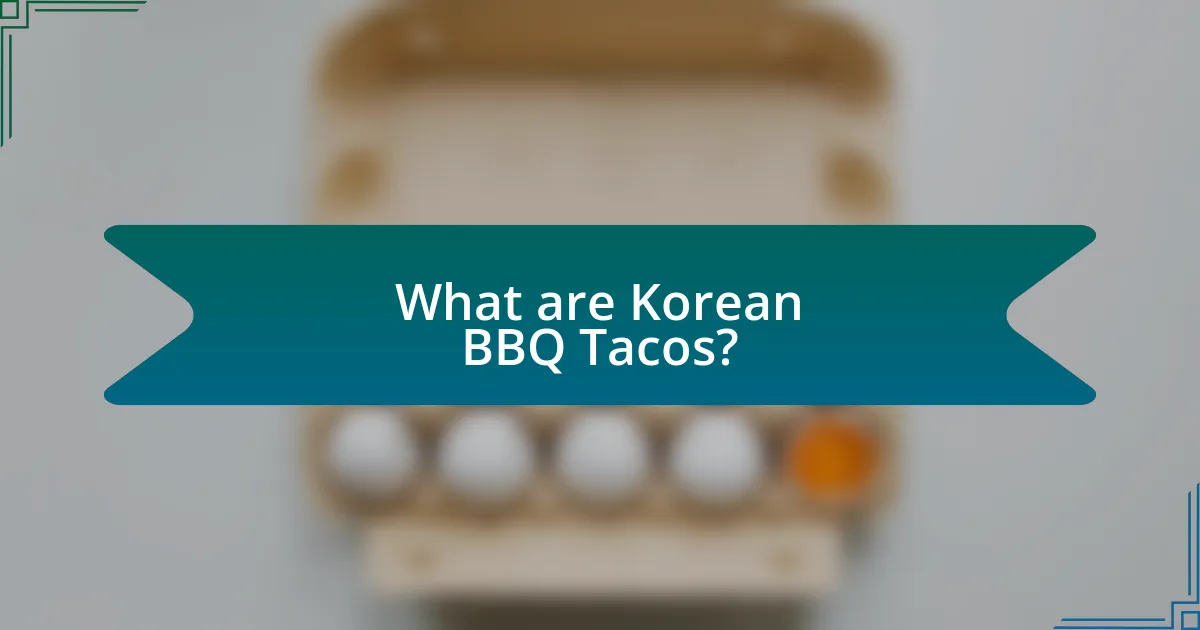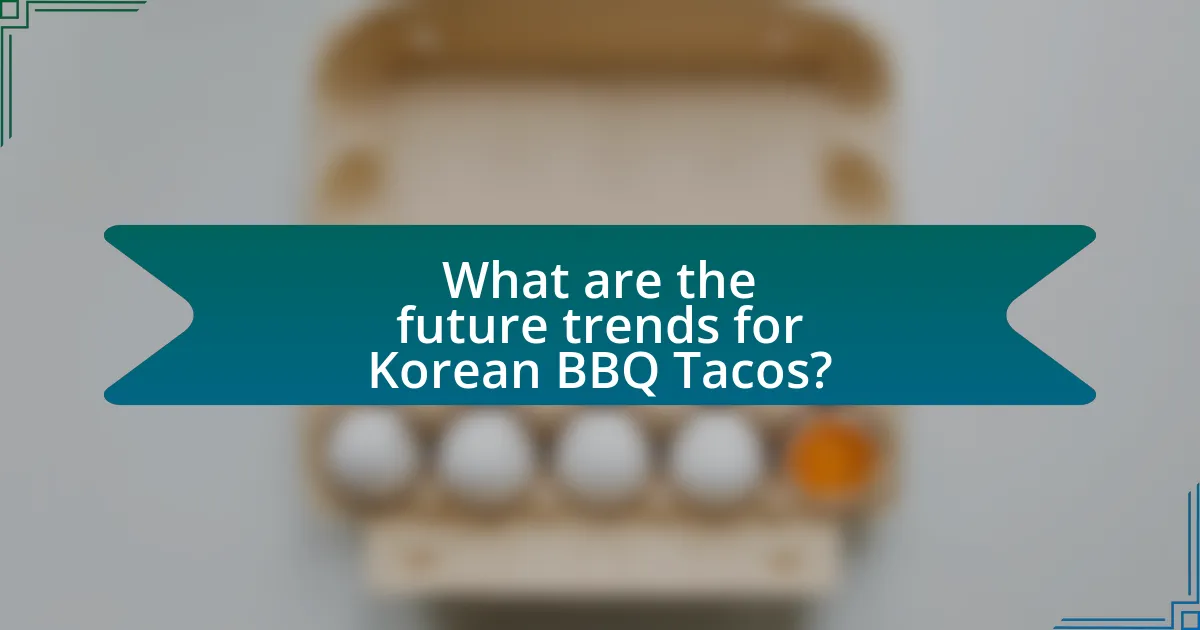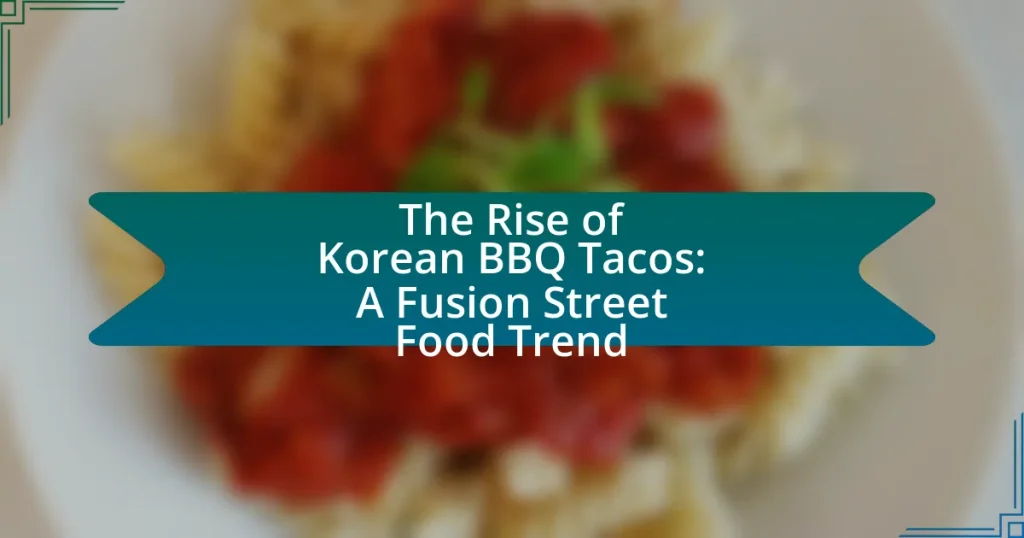Korean BBQ tacos are a fusion dish that merges traditional Korean barbecue flavors with the taco format, featuring marinated and grilled meats like bulgogi or kalbi, served in soft tortillas with toppings such as kimchi and spicy sauces. Originating in Los Angeles in the early 2000s, primarily through the Kogi BBQ food truck, this dish reflects the cultural interplay between Korean and Mexican culinary traditions. The rise of food trucks has significantly contributed to its popularity, making it accessible to a broader audience and appealing particularly to young adults seeking innovative dining experiences. The article explores the ingredients, flavor profiles, and future trends of Korean BBQ tacos, highlighting their unique place within the street food culture and the ongoing fusion food trend.

What are Korean BBQ Tacos?
Korean BBQ tacos are a fusion dish that combines traditional Korean barbecue flavors with the format of a taco. Typically, these tacos feature marinated and grilled meats, such as bulgogi or kalbi, served in a soft tortilla, often accompanied by toppings like kimchi, pickled vegetables, and spicy sauces. This culinary innovation reflects the growing trend of blending diverse culinary traditions, particularly in street food culture, where convenience and bold flavors are highly valued.
How did Korean BBQ Tacos originate?
Korean BBQ Tacos originated in Los Angeles in the early 2000s, primarily attributed to the food truck Kogi BBQ, founded by chef Roy Choi. This innovative dish combines traditional Korean flavors, such as marinated bulgogi beef, with the convenience of a taco, reflecting the multicultural landscape of Los Angeles. The fusion gained popularity through social media, particularly Twitter, which helped Kogi BBQ attract long lines and a dedicated following, solidifying Korean BBQ Tacos as a significant trend in street food culture.
What cultural influences contributed to the creation of Korean BBQ Tacos?
Korean BBQ Tacos emerged from the fusion of Korean and Mexican culinary traditions, reflecting the cultural interplay between immigrant communities in the United States. The Korean influence is evident in the use of marinated meats, such as bulgogi, which is grilled and served in a taco format, while the Mexican aspect is showcased through the incorporation of tortillas and traditional taco toppings like salsa and cilantro. This blend of flavors and cooking techniques symbolizes the broader trend of fusion cuisine, particularly in urban areas with diverse populations, such as Los Angeles, where Korean and Mexican communities coexist. The popularity of Korean BBQ Tacos can be traced back to food trucks and street vendors who creatively combined these two distinct culinary heritages, making them accessible and appealing to a wide audience.
What role did street food play in the popularity of Korean BBQ Tacos?
Street food significantly contributed to the popularity of Korean BBQ Tacos by providing a convenient and accessible way for consumers to experience this fusion cuisine. The rise of food trucks and street vendors in urban areas allowed for the innovative combination of Korean flavors and Mexican taco formats to reach a broader audience. This trend was particularly evident in cities like Los Angeles, where the diverse culinary landscape embraced such fusion dishes, leading to increased visibility and demand. The informal and social nature of street food culture also encouraged experimentation and sharing among food enthusiasts, further solidifying Korean BBQ Tacos as a popular choice within the street food scene.
What ingredients are typically used in Korean BBQ Tacos?
Korean BBQ Tacos typically include marinated meats such as bulgogi (thinly sliced beef) or galbi (short ribs), along with fresh vegetables like cabbage, carrots, and cilantro. Additionally, they often feature toppings such as kimchi, spicy gochujang sauce, and sesame seeds. The combination of these ingredients reflects the fusion of traditional Korean flavors with the taco format, creating a unique street food experience.
How do traditional Korean ingredients enhance the flavor of tacos?
Traditional Korean ingredients enhance the flavor of tacos by introducing bold, umami-rich elements such as gochujang, kimchi, and sesame oil. Gochujang, a fermented chili paste, adds a spicy and slightly sweet depth, while kimchi contributes tanginess and crunch, elevating the overall texture and flavor profile. Sesame oil imparts a nutty aroma that complements the other ingredients, creating a harmonious fusion. This combination not only diversifies the taste experience but also reflects the growing trend of blending culinary traditions, as seen in the popularity of Korean BBQ tacos in street food culture.
What types of proteins are commonly featured in Korean BBQ Tacos?
Korean BBQ Tacos commonly feature proteins such as bulgogi (marinated beef), galbi (short ribs), and spicy pork. These proteins are integral to the fusion of Korean flavors with traditional taco elements, providing a savory and rich taste profile. The use of bulgogi, which is thinly sliced beef marinated in a mixture of soy sauce, sugar, sesame oil, garlic, and pepper, is particularly popular due to its tenderness and flavor. Galbi, known for its sweet and savory marinade, adds depth, while spicy pork, often seasoned with gochujang (Korean chili paste), introduces a kick of heat.

Why are Korean BBQ Tacos gaining popularity?
Korean BBQ Tacos are gaining popularity due to their unique fusion of flavors that combines traditional Korean barbecue with the convenience of tacos. This culinary trend appeals to food enthusiasts seeking innovative dining experiences, as it offers a blend of savory marinated meats, fresh vegetables, and bold sauces, all wrapped in a portable format. The rise of food trucks and casual dining establishments has further facilitated access to this dish, making it a trendy option for consumers looking for quick yet flavorful meals. Additionally, social media platforms have amplified the visibility of Korean BBQ Tacos, allowing food lovers to share their experiences and attract a wider audience.
What factors contribute to the fusion food trend?
The fusion food trend is primarily driven by globalization, cultural exchange, and consumer demand for novelty. Globalization facilitates the blending of diverse culinary traditions, allowing chefs to experiment with ingredients and techniques from various cultures. Cultural exchange, particularly through immigration and travel, introduces new flavors and cooking styles to different regions, further enriching the culinary landscape. Additionally, consumer demand for unique dining experiences encourages restaurants to innovate and create fusion dishes, such as Korean BBQ tacos, which combine elements from Korean and Mexican cuisines. This trend reflects a broader societal shift towards embracing diversity and creativity in food.
How does the rise of food trucks influence the popularity of Korean BBQ Tacos?
The rise of food trucks significantly boosts the popularity of Korean BBQ tacos by providing accessible and diverse dining options. Food trucks allow for the rapid proliferation of fusion cuisine, making Korean BBQ tacos available in various urban areas where traditional restaurants may not exist. This accessibility is supported by the food truck industry’s growth, which saw a 12.5% increase in revenue from 2014 to 2019, according to IBISWorld. Additionally, food trucks often leverage social media for marketing, creating buzz around unique offerings like Korean BBQ tacos, which attracts food enthusiasts and fosters a community around this fusion dish.
What demographic is most attracted to Korean BBQ Tacos?
Young adults aged 18 to 34 are the demographic most attracted to Korean BBQ Tacos. This age group is particularly drawn to fusion cuisine, which combines traditional Korean flavors with the accessibility of tacos. Research indicates that millennials and Gen Z consumers prioritize unique dining experiences and are more likely to experiment with diverse food options, making them key consumers in the fusion food market. Additionally, the popularity of food trucks and casual dining formats aligns with the lifestyle preferences of this demographic, further driving their interest in Korean BBQ Tacos.
How do Korean BBQ Tacos compare to traditional tacos?
Korean BBQ tacos differ from traditional tacos primarily in their flavor profile and ingredients. Traditional tacos typically feature seasoned meats like beef, chicken, or pork, combined with toppings such as lettuce, cheese, and salsa, emphasizing a more straightforward Mexican flavor. In contrast, Korean BBQ tacos incorporate marinated meats like bulgogi, which is sweet and savory, along with toppings such as kimchi, pickled vegetables, and spicy sauces, creating a fusion of Korean and Mexican culinary elements. This blend results in a unique taste experience that highlights the umami flavors characteristic of Korean cuisine, setting them apart from the more classic, spiced flavors found in traditional tacos.
What unique flavors set Korean BBQ Tacos apart from classic Mexican tacos?
Korean BBQ Tacos are distinguished by their unique combination of flavors, primarily influenced by Korean cuisine’s use of marinated meats, bold spices, and distinctive sauces. The use of ingredients such as gochujang (Korean chili paste), sesame oil, and kimchi introduces a sweet, spicy, and umami-rich profile that contrasts with the more traditional, simpler flavors of classic Mexican tacos, which typically feature ingredients like cilantro, lime, and various salsas. This fusion creates a complex flavor experience that highlights the savory, grilled meats commonly found in Korean BBQ, such as bulgogi or kalbi, while incorporating the handheld convenience of a taco.
How do presentation and serving styles differ between the two?
Presentation and serving styles of Korean BBQ tacos differ significantly from traditional Korean BBQ. Korean BBQ typically involves grilling marinated meats at the table, served with an array of side dishes like kimchi and pickled vegetables, emphasizing communal dining. In contrast, Korean BBQ tacos present the fusion in a portable format, often served in soft corn tortillas, allowing for individual servings that cater to street food convenience. This adaptation not only simplifies the dining experience but also merges flavors in a way that highlights the fusion aspect, making it accessible for on-the-go consumption.

What are the future trends for Korean BBQ Tacos?
Future trends for Korean BBQ tacos include increased fusion with other global cuisines, a focus on health-conscious ingredients, and the rise of plant-based options. As consumers seek diverse flavors, Korean BBQ tacos are likely to incorporate elements from Mexican, Asian, and Mediterranean cuisines, enhancing their appeal. Additionally, the growing demand for healthier food choices will drive the use of organic, locally sourced ingredients and lower-calorie options. The plant-based food movement will also influence the market, leading to more vegetarian and vegan Korean BBQ taco offerings, reflecting broader dietary trends. These trends are supported by the increasing popularity of fusion foods and the shift towards sustainable eating habits among consumers.
How might Korean BBQ Tacos evolve in the coming years?
Korean BBQ Tacos are likely to evolve by incorporating more diverse ingredients and flavors, reflecting global culinary trends. As fusion cuisine continues to gain popularity, chefs may experiment with various proteins, such as plant-based alternatives, to cater to the growing demand for vegetarian and vegan options. Additionally, the use of innovative sauces and toppings, such as kimchi aioli or spicy gochujang crema, could enhance flavor profiles and attract a broader audience. The rise of food trucks and pop-up restaurants specializing in Korean BBQ Tacos will further drive this evolution, allowing for regional variations and seasonal ingredients to be featured. This adaptability aligns with consumer preferences for unique and customizable dining experiences, ensuring that Korean BBQ Tacos remain relevant in the competitive street food market.
What new flavor combinations are being explored in Korean BBQ Tacos?
New flavor combinations being explored in Korean BBQ Tacos include kimchi aioli paired with grilled bulgogi, and gochujang-infused salsa with crispy pork belly. These innovative pairings enhance the traditional taco experience by integrating bold Korean flavors, creating a unique fusion that appeals to diverse palates. The use of ingredients like pickled daikon and sesame slaw further complements the savory elements, showcasing the versatility of Korean BBQ in a taco format.
How are chefs innovating with Korean BBQ Tacos in gourmet settings?
Chefs are innovating with Korean BBQ Tacos in gourmet settings by incorporating high-quality, locally sourced ingredients and unique flavor profiles. They elevate traditional elements, such as marinated meats like bulgogi or spicy pork, by pairing them with gourmet toppings like kimchi aioli, pickled vegetables, and artisanal tortillas. This fusion not only enhances the visual appeal but also introduces complex flavors that cater to sophisticated palates. Additionally, chefs often experiment with presentation, serving these tacos on elegant platters or in creative formats, which aligns with contemporary dining trends that emphasize both taste and aesthetics.
What tips can you follow to make the best Korean BBQ Tacos at home?
To make the best Korean BBQ tacos at home, start with marinating high-quality proteins like beef or pork in a mixture of soy sauce, sesame oil, garlic, and ginger for at least 30 minutes to enhance flavor. Use fresh ingredients such as cilantro, green onions, and pickled vegetables to add crunch and acidity, balancing the richness of the meat. Opt for soft corn or flour tortillas, as they complement the fillings well and are easy to handle. Cooking the meat on a grill or stovetop over high heat ensures a nice char and smoky flavor, which is characteristic of Korean BBQ. Finally, serve the tacos with a drizzle of spicy gochujang sauce or a tangy kimchi slaw for an authentic touch. These tips are effective because they incorporate traditional Korean flavors and cooking techniques, which are essential for achieving the desired taste profile in Korean BBQ tacos.
What essential ingredients should you have for authentic Korean BBQ Tacos?
Authentic Korean BBQ Tacos require essential ingredients such as marinated beef (typically bulgogi), corn tortillas, kimchi, and fresh vegetables like cilantro and green onions. Marinated beef, often made with soy sauce, sugar, garlic, and sesame oil, provides the signature flavor of Korean BBQ. Corn tortillas serve as the base, offering a traditional Mexican element. Kimchi adds a spicy and tangy contrast, while fresh vegetables enhance the overall texture and flavor profile. These ingredients collectively create a fusion that reflects both Korean and Mexican culinary traditions.
How can you customize Korean BBQ Tacos to suit your taste preferences?
You can customize Korean BBQ tacos to suit your taste preferences by adjusting the protein, toppings, and sauces. For protein, choose from options like marinated beef, pork, chicken, or tofu, allowing for a variety of flavors and textures. Toppings can include traditional ingredients such as kimchi, pickled vegetables, or fresh cilantro, or you can opt for non-traditional choices like avocado or cheese to enhance creaminess. Additionally, sauces like gochujang, sriracha, or a tangy lime crema can be tailored to your desired spice level and flavor profile. This flexibility in ingredients allows for a personalized culinary experience that caters to individual tastes.


